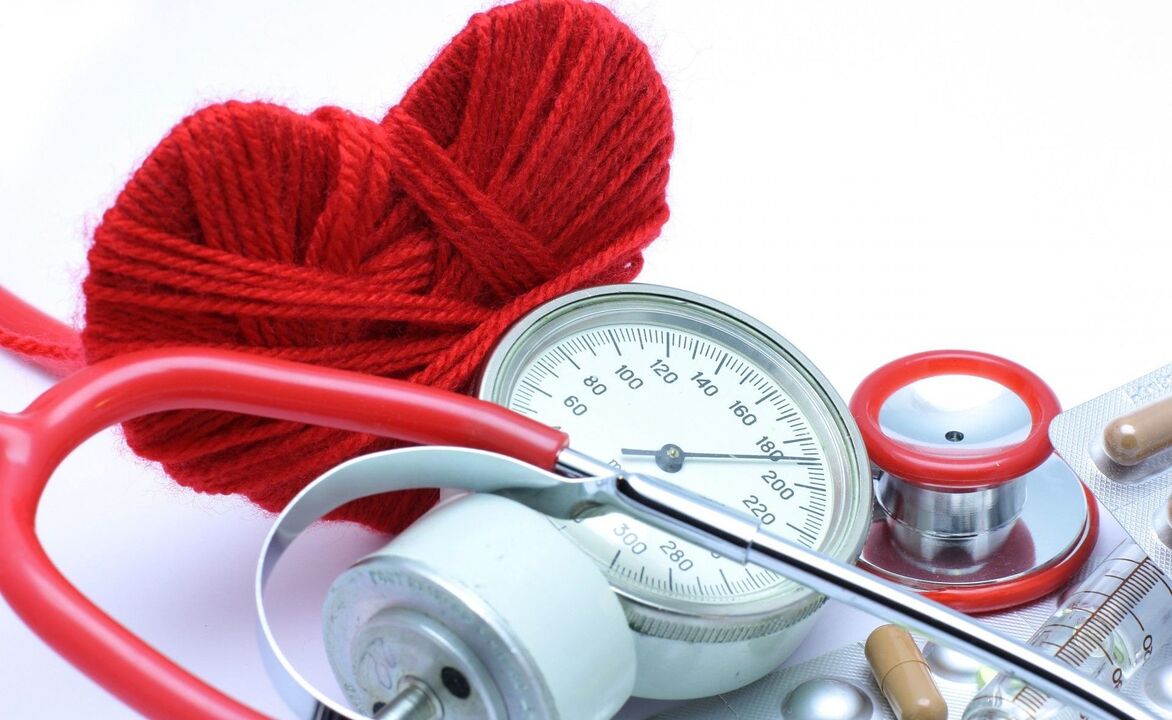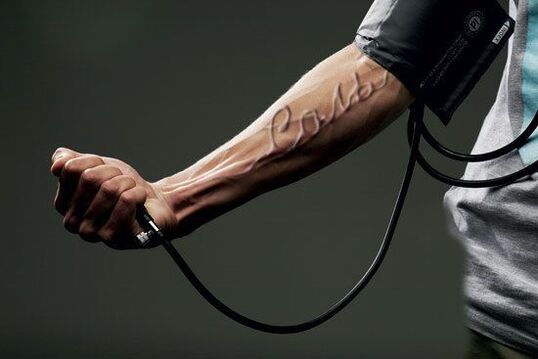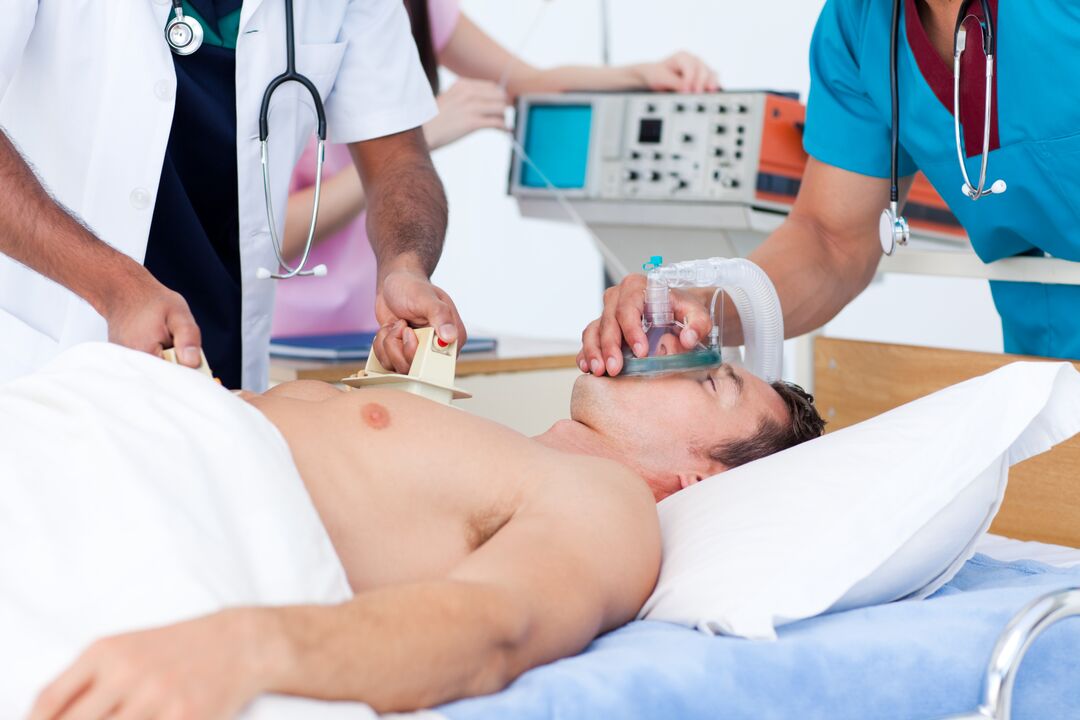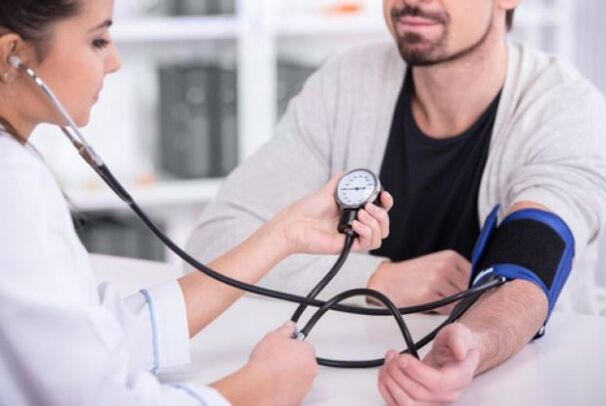According to the World Health Organization, hypertension is one of the most common diseases. Hypertension occurs in every third person, and is characterized by a high mortality rate in the severe phase. Only complex treatment that combines medication and maintenance of a healthy lifestyle can be successful.

What is high blood pressure?
What is hypertension is a chronic disease, a pathology of the cardiovascular system. It develops due to a disruption of the work of the higher centers responsible for the function of blood vessels. The complications of hypertension are dangerous and accompanied by medical diseases.
One of the main manifestations of the disease is high blood pressure (blood pressure), which only decreases after taking specific and powerful drugs.
Hypertension refers to pressure between 140/90 mm Hg. and higher if it is confirmed in two physical examinations.
Hypertension is divided into several types:
- Essential arterial hypertension,
- Symptomatic arterial hypertension,
- chronic hypertension,
- Increased blood pressure.
Symptomatic or secondary hypertension accounts for only 10% of all reported cases of the disease. Hypertensive syndrome - the second name of the disease - is often accompanied by systemic lupus erythematosus, urolithiasis, renal malformations and tumors, ischemia, toxicity in late pregnancy, renal tuberculosis. Despite the fact that hypertension does not have its own signs and features, it aggravates the underlying diseases.
Essential hypertension is an independent form of the disease.
Chronic hypertension is often caused by excess calcium in the blood, infectious diseases (which turn chronic), diabetes, and genetics. It manifests in the form of nervousness, lethargy, fatigue and weakness, frequent numbness of the hands and feet, slurred speech, left ventricular hypertrophy, and frequent pain in the heart region.
How does high blood pressure develop?
The mechanism of the development of hypertension is as follows: in response to a stress factor, a violation occurs in the peripheral circuits of sound regulation. The result is constriction of the arterioles, and the formation of circulatory and dyskinesia syndromes. The secretion of neurohormones in the aldosterone system is significantly increased. This causes a delay in the lumen of sodium and water, which increases blood volume and pressure. During the disease, the viscosity of the blood also increases, which leads to a decrease in the rate of metabolic processes in the tissues. Vessel walls increase in size, the distance between them narrows, affecting blood circulation. Peripheral resistance increases, making the disease impossible to recover. Due to an increase in the permeability and permeability of the vascular wall to plasma, arteriosclerosis and ellastofibrosis develop, and this leads to severe changes in the tissues of some organs.
Hypertension cannot occur spontaneously in humans. Usually, hypertension precedes vegetative vascular dystonia (VD), its frequent companion being varicose veins.
Varicose veins and hypertension are related: increased activity of the vessel walls in SVD leads to a decrease in their diameter. The resistance of the vessel walls to increased blood flow increases blood pressure. Varicose veins are characterized by thickening of the vessel wall, the formation of pockets and internal constriction, which interferes with the normal circulation of blood. Diseased veins are no longer able to cope with blood flow, leading to the formation of edema in the tissues and chronic stagnation in the veins. This can turn into the development of gangrene, sepsis and even death.
Classification of diseases
Hypertension varies in etiology, organ damage, and severity and course of blood pressure. The disease can be benign, or slowly progressive, or rapidly progressive - malignant. More important is the classification according to the degree and stability of the pressure. Distinguish:
- GB normal (up to 129/85 mm Hg),
- contour (up to 140/90 mm Hg),
- grade 1 hypertension (up to 160/100 mm Hg),
- 2 degrees (up to 180/110 mm Hg),
- 3 degrees (above 180/110 mm Hg).
Benign hypertension has three stages. The first or light is characterized by increased pressure up to 180 to 104 mm Hg, but after a short rest, it returns to normal. Some people complain of headaches, trouble sleeping, fatigue, and decreased productivity at work. However, in most cases, the mild phase occurs without obvious individual symptoms.
The second or middle stage is characterized by pressures up to 200 to 115 mm Hg. at the rest. Accompanied by sharp and strong pain in the head, dizziness, pain in the heart area. During the examination, heart damage was detected. Sometimes submyocardial ischemia is detected. Cerebral infarction, transient ischemic attack may occur.
The third or severe stage is accompanied by a steady and strong increase in pressure. At the beginning of the period, the pressure rises intermittently, and often manifests itself after exertion, as well as changes in barometric pressure, erratic emotional ups and downs. May normalize after myocardial infarction or stroke. After a myocardial infarction, headless hypertension often occurs. That is, a state when only the systolic pressure or pulse decreases.
The reason for the development of the disease
The cause of hypertension lies in a violation of the regulatory activity of the main parts of the central nervous system, which control the work of all internal organs. Frequent overwork and overwork, both physical and mental, unrest, prolonged, constant and intense stress can lead to development.
Working at night, often in noisy environments, can also trigger flare-ups.
The risk group includes people who love salty foods. Salt causes the arteries to constrict and prevents fluid removal. Heredity plays an important role. The likelihood of the disease occurring is increased if blood pressure is raised in two or more relatives.
Some diseases also provoke the development of hypertension. Including:
- Diseases of the adrenal glands and kidneys,
- thyroid disease,
- Fat,
- diabetes,
- tonsillitis,
- Atherosclerosis.
Among the group of women most at risk are those who are in menopause. This is due to hormonal changes in the body, emotional outbursts, nervous reactions. It is during menopause that about 60% of all diseases in women occur.

In men, age and sex determine increased risk. Hypertension in the 20s and 30s develops in about 9% of men. At the age of 40, this rate increases to 35, and after the age of 65 - already 50%. Hypertension is more common in men under the age of 40 than in women. In the older age group, this ratio varies - this is explained by a large proportion of men who die from complications.
The cause of hypertension lies in low blood pressure and bad habits. The components of cigarette smoke cause blood vessel constriction and damage the thin walls of the arteries. Less physical activity is associated with a slow metabolism, and in the event of an increased load, the untrained heart will tire many times faster.
Symptom
Clinic early-stage hypertension can be mild. A person for a long time may not even be aware of the increase in pressure and the processes that develop in the vessels. The first and foremost signs of hypertension are unexplained irritability and increased fatigue.
Symptoms of hypertension in the early stages: nervous confusion, weakness, sleep disturbances, noise and tinnitus and dizziness, heart palpitations.
People note reduced efficiency, loss of concentration. There was a shortness of breath. Hypertensive headaches are more common in the morning in the temporal and occipital regions. Towards the end of the day and in the supine position may increase. They are associated with a violation of the tone of the venules and arterioles. Symptoms of hypertension include pain in the area of the heart. This is because the heart muscle has to work harder to overcome the increasing resistance. As a result, a dissociation occurs between myocardial demand and capacity, leading to angina.

Signs of later hypertension are the veil and flashing of the "flies" in front of the eye, as well as other examination findings. They are explained by constriction of the arterioles of the retina. Malignant hypertension may be accompanied by hemorrhage in the retina, leading to blindness. In rare cases, the symptoms of hypertension are manifested by vomiting, swelling of the hands and fingers, chills, in the morning - heaviness in the eyelids and puffiness of the face, profuse sweating.
Complications of high blood pressure
Complications of high blood pressure:
- hypertensive crisis,
- blind,
- Circulatory disorders in the brain
- renal sclerosis,
- subarachnoid hemorrhage,
- aortic aneurysm surgery,
- bradycadia,
- Damage to target organs (kidneys, heart, brain, veins and arteries, blood vessels),
- Hypertensive cardiomyopathy (HLH, left ventricular hypertension)
- Hypertonic Angiodystonia.
The hypertensive crisis
First you need to understand what a hypertensive crisis is. This term refers to an acute and significant increase in blood pressure accompanied by characteristic symptoms of the disease. In addition to hypertension, it can be caused by:
- Chronic and acute glomerulonephritis,
- Toxicosis in late pregnancy,
- vascular hypertension,
- benign brain tumor,
- heavy metal poisoning,
- CKD.
Crises can be caused by hormonal imbalances and sudden changes in weather. One of the most common causes is emotional trauma. Symptoms: severe and severe headache, nausea with vomiting, dizziness, fainting, short-term blindness and other visual disturbances, weakness, mood swings, lacrimation. Brain symptoms:
- vasospasm,
- Violation of the permeability of the vascular wall,
- Infiltration of plasma into the marrow, leading to edema.
In the early stages of the disease, critical attacks are mild and short-lived.

The potential for a development crisis to occur:
- retinal detachment,
- The hit,
- Pulmonary edema
- heart asthma,
- heart attack,
- Chest pain.
The complications of hypertension pose a serious threat to human life, requiring regular monitoring by a doctor.
Bradycadia
A frequent and dangerous complication of hypertension. It manifests itself according to form. Mild forms may go unnoticed. Severe, frequent and prolonged dizziness accompanied by increased blood pressure may indicate a pronounced form of the disease. In addition, the symptoms include - a state of semi-syncope and frequent fainting, sudden changes in pressure. The severe form is accompanied by fainting and short-term cardiac arrest. Treatment of bradycardia with possible hypertension with homeopathic remedies and drugs. Commonly prescribed diuretics, alpha blockers, nifedipine. From homeopathy, calendula, St. John's wort, strawberry, shakers are prescribed.
Complications include the following syndromes in hypertension:
- myocardial injury,
- kidney damage,
- vascular encephalopathy,
- Arterial hypertension syndrome.
Related clinical conditions: ischemic stroke, CHF, coronary revascularization, renal failure, arterial disease, papilledema.
Target organ damage
A heart
Usually, left ventricular hypertrophy develops. This happens because the heart muscle has to try to push blood into the deformed vessels. Doing so leads to thickening of the muscle walls and lack of blood circulation. This is very dangerous with muscle tension and heart failure. Another pathology is a violation of the diastolic function of the lzh. The increasing fatigue of the heart muscle leads to a point where it cannot take a comfortable position. The thickened wall cannot relax during diastole, during which oxygen saturation normally occurs. All this leads to the third pathology - chronic failure. It develops due to constant oxygen starvation. The disease is difficult to treat, combined with other diseases easily leads to death.
Ship
Arteries in hypertension are always in a state of constant narrowing due to the contraction of the muscle layer. This leads to the fact that the vessels stop relaxing and muscle tissue is replaced by connective tissue. This is called vascular remodeling. Vision loss, peripheral atherosclerosis of the extremities and other diseases are associated with this complex and irreversible consequence.
Brain
Hemorrhage causes nearly 25% of all strokes. And hypertension is a major cause of bleeding, with a high mortality rate. Insufficient blood supply to the brain leads to ischemic stroke. This complication accounts for more than 70% of cases. It is caused by a narrowing or blockage of a cerebral artery due to a blood clot. Another pathology is hypertensive encephalopathy. This is an emergency condition, accompanied by severe headache, high blood pressure, neurological symptoms. If you have high blood pressure, then you are more likely to have cognitive decline and dementia. These are changes in the subcortical substance and brain atrophy, which lead to a violation of thought processes.
kidney
One of the most common complications is microalbuminuria. The earliest signs of kidney damage and the development of kidney failure. Chronic kidney failure is characterized by the inability of the kidneys to remove metabolic products from the blood.
Diagnostic
Effective treatment of hypertension is possible only with early diagnosis and observance of all rules and recommendations. High blood pressure is not always a sign of hypertension, it can be due to the situation. And with many visits to the doctor, nothing was found. A single manometry may not reveal the disease: with recurrent symptoms, dynamic blood pressure should be measured. After diagnosis, doctors conduct differential diagnosis to determine the symptomatic form of the disease.

Pressure Gauge
To determine the extent and presence of disease, dynamic pressure measurement is used. It is done as follows: the atmosphere should be comfortable and quiet. Measurements began no earlier than ten minutes after the patient started admission. One hour before the exam, smoking, drinking any strong food and drink (tea, coffee, alcohol), any physical activity, using eye drops or nose drops are excluded. During the first treatment, blood pressure readings were taken from both hands of the patient, the second measured after 2 minutes.
With a reading difference of more than 5 mm Hg. Continue the measurements on the arm with high pressure.
Treatment of high blood pressure
How to treat high blood pressure depends on the stage of the disease, complications, age, and many other parameters. Medical treatment options are selected by the attending physician. The desire to fight the disease on your own can turn into disastrous consequences. Modern treatment of hypertension begins with non-pharmacological methods that increase the effectiveness of drugs many times over. You need to start by establishing a daily routine, remove all stress, do not forget to exercise and go hiking. An important point in how to deal with hypertension is diet. Patients should refuse or significantly reduce their salt intake, drink less, and completely eliminate alcohol and coffee. If you follow all the recommendations, you can avoid drug treatment of the disease.
In treatment, it is important not only how to treat high blood pressure, but also how to eliminate the cause of high blood pressure.
Usually drugs are used to treat:
- Diuretic,
- Inhibitors
- Type 2 . receptor antagonists
- Calcium blockers.
Blood pressure medication - prescription only
homeopathic treatment
Considering the question of how to get rid of hypertension, it is worth noting homeopathic remedies. They are usually recommended when target organs are already affected. Homeopathy for hypertension has one important advantage: its mild effect. The drug has no contraindications or side effects. The disadvantage is that the treatment with homeopathic remedies is quite slow. When choosing this method, consider:
- Homeopathic medicines are prescribed simultaneously with drugs,
- Combination of medication and healthy lifestyle
- With a moderate level of risk, this is usually the only one that can occur.
Inpatient treatment of hypertension
Inpatient treatment is usually received with a complicated hypertensive crisis:
- Acute hypertensive encephalopathy,
- heart asthma,
- pulmonary edema,
- Acute coronary syndrome (unstable angina and myocardial infarction),
- aortic aneurysm,
- Severe arterial bleeding
- Eclampsia.
After admission, the clinic's doctors begin to perform the main diagnostic manipulations:
- Every 15 minutes of dynamic blood pressure measurement,
- ECG,
- General analysis of blood and urine,
- echocardiography,
- Biochemical analysis to detect potassium, sodium, urea, calcium, creatinine, fibrinogen, coagulation chart,
- Check the bottom of the eye.
In addition, the patient must be assigned an appointment with a neurologist, a Reberg test and an encephalogram, as well as a hemodynamic type of the brain. While in the hospital, inpatient treatment depends on the presence of complications, the severity of the attack, and other illnesses. First aid is aimed at reducing the activity of the left ventricle and eliminating symptoms such as:
- peripheral vasoconstriction,
- Ischemic,
- Heart failure.
Of great importance in the management of a complex episode are the use of antihypertensive drugs, ICU admission, and frequent blood pressure checks.
Treatment of high blood pressure without medication includes boosting immunity, cleansing the body, massage, gymnastics, and diet. It is important to follow your doctor's instructions, and not violate the established regimen.
How to live with high blood pressure?
How long people with high blood pressure live is an important question for those already diagnosed. The consequences of the disease depend on the stage and nature of its process. Severe form, vascular lesions, third stage of disease and target organ disruption worsen prognosis. Early death occurs from heart attacks and strokes, acute heart failure. The prognosis is not favorable for those who were ill at an early age.
The life expectancy of a patient with hypertension depends not only on the correct intake of medication and regular visits to the doctor, but also on individual attitudes and observance of the basic rules. Including:
- psychological climate,
- Diet,
- Do exercise,
- No bad habits.
Another important condition is to have a clear understanding of what kind of disease this is, how it develops and its consequences on the whole body. To understand the features of the disease process, it is not necessary to have a medical education. There are many great books and guidebooks written for the average person. One of them is A. Yakovlev's "Preconditions of Medical Diseases", which briefly and clearly presents the main regulations for hypertension, as well as the most common antihypertensive treatment regimens. .
Psychological climate
Once you've figured out how to treat high blood pressure and choose your treatment, it's time to move on to an equally important issue - a healthy lifestyle. Not possible during night shifts, frequent quarrels, constant travel, mental stress, negative emotions, fear, anger. All these conditions are accompanied by the production of adrenaline in large quantities, which leads to disorders of the circulatory and nervous systems. The key is to control your emotions, think more positively, and eliminate any sources of stress from your environment. Herbal tea, meditation, walking, doing what you love will help in this.
By creating the most comfortable conditions around you, a person increases his or her chances of recovery.
Diet
Excess weight and high blood pressure are not compatible. Even without additional weight gain, treatment begins with nutritional adjustments. In the first stage, this is enough to control the pressure and prevent its rise. There are several ways to lose weight when you have high blood pressure. The main thing is to limit calories. This can be achieved by eliminating or reducing the daily intake of sweet and fatty foods and flour products. Diet for weight loss should not be confused with fasting: it is forbidden for patients with high blood pressure. To lose weight and normalize blood pressure, you should also monitor the amount of animal fat in food. It is necessary to eliminate foods high in cholesterol as much as possible, as well as switch to fish, fruits and vegetables that are low in fat and natural vegetable oils. Avoid sausages, lard, fried meatballs and fatty meats, butter, and cheeses.
Contraindications for hypertension - any drinks and foods that stimulate the nervous system. These include not only tea, coffee and alcohol, but also carbonated drinks, hot spices, and smelly spices.
It is important to include foods rich in potassium and magnesium in your diet. These elements have a good effect on the heart muscle, strengthen the vessel wall and the nervous system. A lot of potassium is found in:
- prunes,
- apricots,
- cabbage,
- pumpkin,
- Banana.
Rich in magnesium:
- Buckwheat, oats and millet,
- Carrot,
- Sugar beet,
- black currant,
- Parsley leaves and lettuce
- Walnuts.
An important rule of thumb: these products should not be combined with milk. Calcium negatively affects the digestibility of the elements.

Do exercise
The complications of arterial hypertension and the disease itself do not mean that the patient should give up any activity. Exercises, simple movements, yoga or long walks, swimming are indicated for patients with hypertension. This move not only brings positive emotions, but also helps fight excess weight.
You should start with the simplest exercises, gradually increasing the time and complexity of the exercises. This also applies to swimming and walking.
Rehabilitation for people with stage three hypertension, as well as with complications such as hypertensive stroke, coronary artery disease, and angina attacks, should take place only under the supervision of a physician. Usually, for rehabilitation, patients are sent to special resorts, to treatment in nursing. Which includes a full range of measures: proper nutrition, physical exercise, medication.























